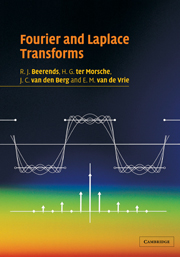Book contents
- Frontmatter
- Contents
- Preface
- Introduction
- Part 1 Applications and foundations
- Part 2 Fourier series
- Part 3 Fourier integrals and distributions
- Part 4 Laplace transforms
- Part 5 Discrete transforms
- 15 Sampling of continuous-time signals
- 16 The discrete Fourier transform
- 17 The Fast Fourier Transform
- 18 The z-transform
- 19 Applications of discrete transforms
- Literature
- Tables of transforms and properties
- Index
19 - Applications of discrete transforms
Published online by Cambridge University Press: 05 June 2012
- Frontmatter
- Contents
- Preface
- Introduction
- Part 1 Applications and foundations
- Part 2 Fourier series
- Part 3 Fourier integrals and distributions
- Part 4 Laplace transforms
- Part 5 Discrete transforms
- 15 Sampling of continuous-time signals
- 16 The discrete Fourier transform
- 17 The Fast Fourier Transform
- 18 The z-transform
- 19 Applications of discrete transforms
- Literature
- Tables of transforms and properties
- Index
Summary
INTRODUCTION
Applications of discrete transforms can mainly be found in the processing of discrete signals in discrete-time systems. In chapter 1 we have already discussed such systems in general terms. Since we now have certain discrete transforms available, we are able to get a better understanding of the discrete systems. Hence, in the present chapter we we will focus on a further analysis of the discrete-time systems.
In systems theory we distinguish inputs and the corresponding outputs or responses of the system. For discrete-time systems these signals are discrete-time signals. A system can be described by giving the relation that exists between the inputs and the outputs. This can be done in several ways. For example, by describing the relation in the n-domain, or in the z-domain, or, just as important, by describing it in the frequency or ω-domain. In the latter case we have the relationship between the spectra of the input and outputs in mind.
Discrete transforms play a special role in linear time-invariant discrete systems, similar to the role played by the Fourier integral in continuous-time systems (see chapter 10). Linear time-invariant systems have already been introduced in chapter 1 (see section 1.3.2). Discrete-time systems that are linear and time-invariant will henceforth be called LTD-systems for short. In section 19.1 we will see that for an LTD-system the relationship between an input and the corresponding output can be described in the n-domain by means of a convolution product.
- Type
- Chapter
- Information
- Fourier and Laplace Transforms , pp. 412 - 428Publisher: Cambridge University PressPrint publication year: 2003



